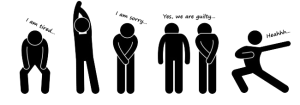 Kinesics is the study and interpretation of body movements—such as facial expressions, gestures, posture, and other visible actions—as a form of nonverbal communication.
Kinesics is the study and interpretation of body movements—such as facial expressions, gestures, posture, and other visible actions—as a form of nonverbal communication.
Body motion, like spoken language, could be analyzed as a system with its own basic units called kines, kinemes, and kinemorphs.
Kinesics encompasses facial expressions, gestures, posture, gait, and other body movements.
Movements can express emotions, attitudes, intentions, or supplement verbal messages.
Kinesic cues are often subconscious and can be more revealing than spoken words.
Kinesics plays a crucial role in social interaction, often conveying more meaning than words alone.
It is estimated that only 30-35% of social meaning is carried by spoken words; the rest comes from nonverbal cues like kinesics: Smiling, frowning, nodding, waving, crossing arms, and eye contact are all forms of kinesic communication.
Ssome estimates suggesting that 55% of communication is through body language, though the exact percentages are debated among researchers.
Key components of kinesics include: Facial expressions – eyebrow movements, eye contact, smiles, frowns Hand and arm gestures – pointing, waving, emblematic signs Body posture – how someone sits, stands, or positions themselves Head movements – nodding, shaking, tilting Proxemics – spatial relationships and personal distance
Kinesic behaviors vary dramatically across cultures.
Kinesics is valuable in psychology, anthropology, law enforcement, business negotiations, and interpersonal relationships.
Understanding kinesic nonverbal cues helps people interpret emotions, intentions, and social dynamics more accurately.
